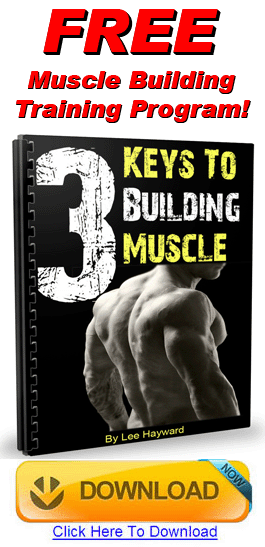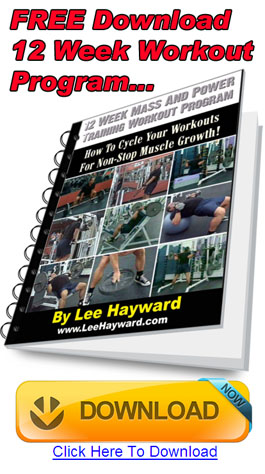Injuries Suck…
There’s nothing worse than being on a role with your training routine, making good gains in the gym, and then getting side tracked with an injury.
Weight training is a very demanding sport. All that pushing, pulling, and straining against heavy weight is potentially dangerous.
Even if you take precautions to avoid injury such as warming up your body before hitting the weights, and doing progressively heavier warm up sets for all your exercises. There is still a risk of getting injured.
And when those injuries do occur, you need to know the proper way to treat them to speed up recovery and to avoid causing further damage.
The most recommended form of injury treatment is the RICE Therapy…
And I’m not talking about Uncle Ben’s or Rice-A-Roni.
RICE stands for:
– Rest
– Ice
– Compression
– Elevation
And even though this has been the recommended advice for injury rehab for decades, there is new research that shows RICE – specifically the Ice – actually causes more harm than good when treating injuries.
No RICE for you…
Ice packs have been traditionally used to cool an injured area to reduced inflammation and swelling. But does this actually help with recovery? Researchers have found that when you cool an injury through icing, blood vessels contract and blood flow is reduced. When you limit blood flow to an injured area you are actually hindering the body’s natural healing process. In some cases icing can even cause nerve and tissue damage to the injured area due to lack of blood flow.
In the case of muscle tears, icing the area can cause a lot of damage. Just think about it, if you have freshly torn muscle fibers and then you ice them, they are going to contract, and this will cause the torn muscles to shorten and separate even more. This is the exact opposite of what you want to have happen.
Ice Slows Muscle Recovery…
There was a study done in 2013 involving eleven 20 year old male baseball players to examine the effects icing had on recovery exercise. Muscle damage markers and hemodynamic changes were checked. And the data suggests that topical cooling (aka using ice packs) does not improve, but rather delays recovery from exercise-induced muscle damage.
What about joint inflammation? Should we ice sore joints?
While it’s true that using a cold pack can reduce inflammation, this is NOT a good thing. Inflammation is necessary because it plays an important role in the healing and recovery process. When joints and tissue get injured through trauma or vigorous exercise, they actually require inflammation to heal.
The body’s natural response to an injury is to send inflammatory cells to the damaged tissue to promote healing. The body releases a hormone called insulin-like growth factor (IGF-1) into the damaged tissues, which helps muscles and other injured parts to heal. But if you apply ice to the injury to help reduce swelling, you are actually delaying the healing process by preventing the body from releasing IGF-1.
Should You Apply Heat To An Injury?
Since we just covered how ice isn’t going to help heal an injury, what about heat? Well this isn’t really going to help either. Adding more heat to an injury could potentially make it get inflamed even more. The best thing to do is simply keep the injury at a comfortable body temperature. Neither too hot, nor too cold.
However, you can use heat when dealing with chronic pain, stiffness, or muscle soreness. For example, if you have a stiff back that’s not caused by a new injury, you can actually use a heating pad to help improve blood circulation to the muscles and this can provide some relief of pain and discomfort.
Another time you can use heat is when recovering from muscle soreness. The day after a hard weight training workout it’s common to feel stiff and sore in the body parts you trained. This is not an injury, it’s just delayed on set muscle soreness. In these cases using heat can help improve blood flow and speed up recovery to the sore body parts.
Hot & Cold Water Therapy…
Another option that works well for dealing with chronic pain or muscle soreness is using hot and cold water therapy. This is my personal favorite and you can do this when getting a shower. Simply turn the water on as hot as you can comfortably stand for 2 minutes, then switch the water to as cold as you can comfortably stand for 1 minute. Keep alternating back and forth a few times.
How this works is when you apply hot water to the body, blood is flushed to the surface of the skin. And when you apply cold water to the body, blood is pulled to the core. By alternating back and forth you can actually circulate blood throughout the muscles without physically doing anything. This is great for speeding up recovery of muscle soreness.
You can do hot and cold therapy with a variety of things. For example; if you have a cool swimming pool and a hot tub. A cold shower and a hot tub. A cold shower and a sauna. Etc. The general rule is to spend about twice as long in the heat as you do in the cold and simply alternate back and forth.
What To Do If You Get Injured…
If you do suffer an injury, the main thing to do is STOP whatever you are doing and rest. Don’t try and be a tuff guy and work through your injury. That’s just stupid. You should wrap and support the injured area with an elastic support bandage like those ACE Bandages that you can get at the pharmacy. Just wrap it tight enough to provide some nice mild support, but not so tight that you are cutting off circulation and restricting blood flow. If possible, elevate the injured body part to use gravity to help minimize swelling.
How you proceed from here depends on how bad the injury is. If you just pulled a muscle, chances are it will heal up on it’s own within several days or a week. But if you tore a muscle, damaged a tendon, ligament, or dislocated a joint than you should get it checked out ASAP by a medical professional.
A serious muscle or tendon tear may need to get surgically re-attached. Where as a minor muscle tear maybe able to heal on it’s own with proper recovery and rehabilitation training. This will need to be decided by a pro. But if you’re in doubt, get it checked out.
For more info about injury re-hab, check out my videos below…
Rotator Cuff Exercises for Rehabbing Shoulder Injuries
Tennis Elbow Exercises for Rehabbing Tendonitis
Golfers Elbow Exercises for Rehabbing Tendonitis
Lower Back Exercises to Help Prevent Back Injury
Pre-Workout Warm Up for Injury Prevention
For more information about how ice slows the healing process, rather than helping it, check out this article by Gabe Mirkin, MD: http://drmirkin.com/fitness/why-ice-delays-recovery.html
About the Author:
 |
Lee Hayward started working out in 1990 and began competing in bodybuilding competitions in 1995. Then in 1999 he started www.LeeHayward.com the very website you are reading right now. Over the years Lee has committed himself to helping aspiring bodybuilding and fitness enthusiasts improve themselves by gaining muscle, burning body fat, and developing a strong healthy body.
If you would like Lee to help you get in your personal best shape with personalized diet and training advice. Then you should consider becoming a member of the Total Fitness Bodybuilding “Inner Circle” Coaching Club. |
As an “Inner Circle” member you’ll get direct access to Lee Hayward through Live Video Chats, along with the Workout Of The Month Program, Muscle Building & Fat Loss Diet Plans, and the Private Members Only Discussion Forum, where you can chat with other like minded members who are serious about getting in their best shape and who share the same goals as you.







4 Comments
Orly
Thanks for this info mr. Lee actually I have injury at my hip. That time I do a squat, now I’m ok because I rest
Orly
I hate squat and hack squat…. Legday is my weakness
Michael
Thanks for the article. My chiropractor tells me there is no difference between ice and heat. They both send the same signals to the body and both do a great job in alerting the brain to a problem in the body. I’m not sure I believe him though because he has some other very strange ideas I’m not so sure about!
Meg
I learned this from my nursing school, too. The immediate and appropriate intervention for an injury is absolutely RICE which stands for Rest, Ice, Compression, and Elevation.
You have explained it well, two thumbs up for you!